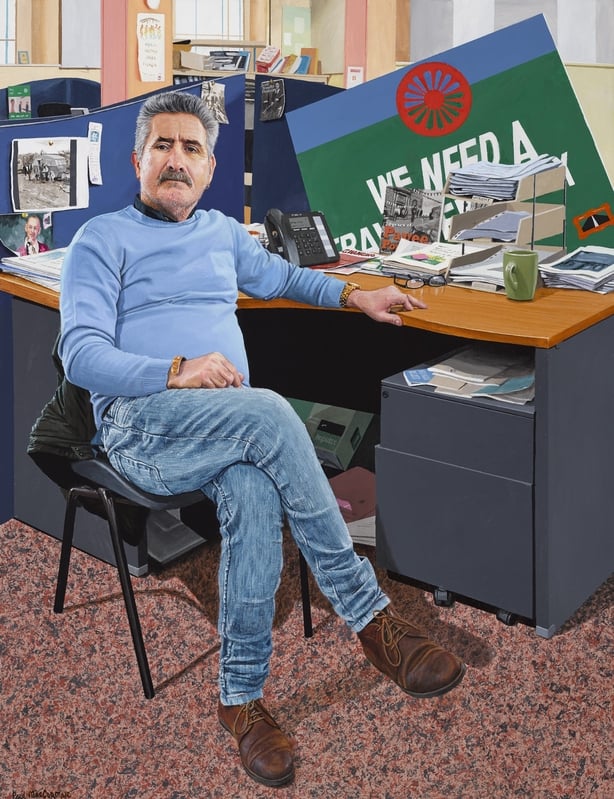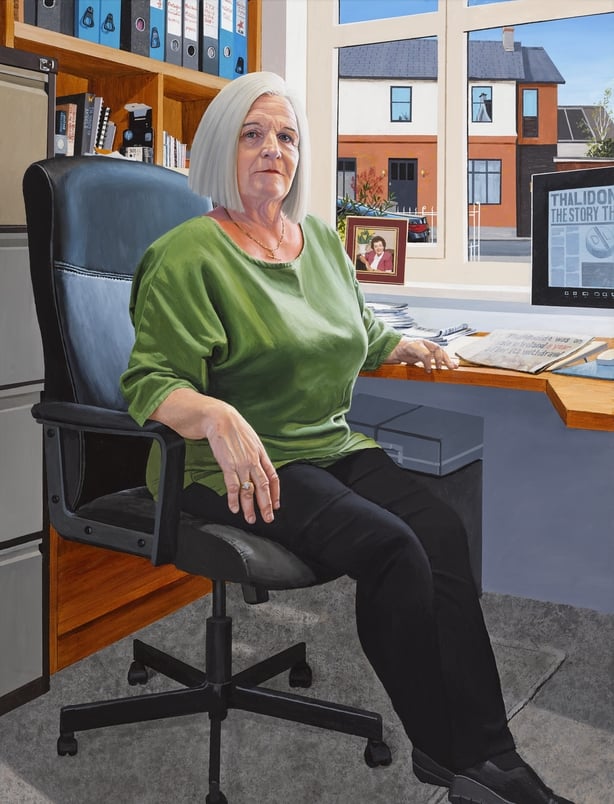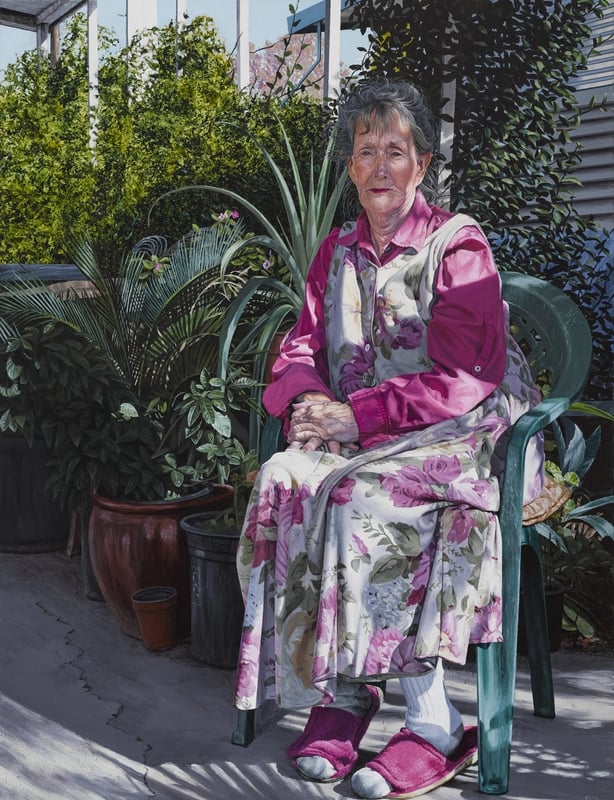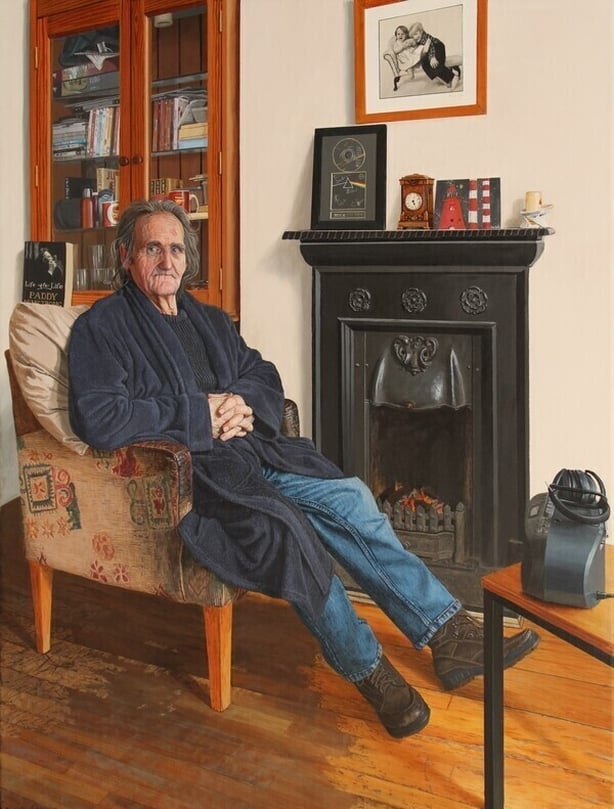The Vanquished Writing History, a new body of work comprising 18 large-scale portraits by artist Paul MacCormaic, are portraits of people, or their advocates, who find themselves marginalised, ostracised, vilifiedor disbelieved, and who have told their own story.
On a blustery Thursday evening in February the RHA Gallery atrium space is plódaithe, lán le daoine for the opening of Paul Mac Cormaic's exhibition 'The Vanquished Writing History'.
Nuair a chuimhnímid ar an Acadamh Ibeirneach Ríoga agus taispeántas portráidí, mhaithfí dúinn bheith ag súil le h-acadamhaithe i gclócaí...fireann, go príomhdha.
This exhibition of portraits is far from that, Paul Mac Cormaic is a highly accomplished painter–traditional in his materials, technique and painting process. His subjects however be seen to be somewhat unconventional portraits.

Agus is anseo atá obair shaoil Paul suite - le fíanaise a thabhairt, an scéal a insint, le bualadh leis an duine lena scéal a insint - ní mar íobartach le trua a dhéanamh leo ach lenár meas a léiriú agus le honóir a thabhairt - dá ghníomhaíocht, dá stocaireacht - don dúshlán a thugann siad don éagóir agus don chlaontacht inár sochaí - seo is ann do 'The Vanquished Writing History'.
And they are brilliant and beautiful painted portraits – not without pain, struggle and sufferinginherent and here presented with dignity as heroic, ordinary heroes.
We are confronted with each person, looking at us – they hold our gaze, testimony to their life and campaign as activist.
Seo daoine atá a dhéan troid, strachailt agus feachtaisíocht i gcoinne stáit, rialtais nó cúirteanna Eorpacha le go n-éistfí lena scéalta agus a gcásanna agus go n-aithneofaí a gcearta daonna agus a gcóir.
People who have fought, struggled and campaigned against our state, our government or European courts for their story, their cases to be heard and their human rights and justice be recognised.

Tá gach ábhar lonnaithe in áit atá roghnaithe acu féin, go minic go neamhfhoirmeálta i suíomh teaghlaigh. Sa bhaile ag bord na cistine - do chuid mhaith acu in oifig feachtais; stair na feastasaíochta, a stair féin léirithe tré leabhair, grianfhraif, cartlannaí, altanna nuachtáin, fearais agus cuimhneacháin dá dhílse cailte thart ortha.
Each model is posed in a place of their choosing, many informal in their domestic setting. At home at their kitchen table – for many the site of their campaign office; the history of their campaign, their history illustrated through the surrounding books, photographs, archives, newspaper articles, paraphernalia and shrines to their lost ones.
Cuimhnímid ar an bportáidíocht agus a ról stairiúil léirithe, bealach le saibhreas, uaillmhian agus cumhacht a thaispeáint - smaoinigh ar phictiúir íocónach Holbein, 'The Ambassadors'.
Here, the artist takes the tropes of traditional portraiture and places it in the service of the agitators.
But these are not just dispassionately documented. The are brilliantly and beautifully painted, traditional and classical in their technique of underpainting built up to highly detailed painted surface.
Look closely at these paintings – get up close see the skill of the artist’s craft in creating the multitude of surfaces, textures and reflected light within each portrait.
Tá siad seo ina macasamhail d'ealaíontóirí Ollónacha na saothar neamhbheo agus loinnir éadaigh na soilse frithchaite san am sula raibh grianghraifeadóireaht ann.
Here, the contemporary materials of a well-worn pine table surface, a kitchen chair contrasted against at tiled lino as in the portrait of Martin and Peggy Murphy (Members of the Thalidomide Association), are rendered perfectly in paint, a glowing brushstroke of cerulean blue against a pale lemon yellow capturing light reflected.
Sa solas gréine ballach, nádúrtha ar phátrúin éadaigh agus duilliúir sa phortráid gleoite de Annie Murphy, iar leannáin an tEaspag Eamon Casey, ina tigh sa bhaile i gCalifornia.

Paul documents his painting process, talking about how he might paint a particular surface or illusion. A detailed technique required in the mis en abyme – the images within images within the painting as in Antoinette Keegan, spokeswoman for Justice for the Startdust 48, or John Teggart, victim’s campaigner at Springhill Community House, Belfast.
But it is in the artists painting of faces and hands, the skin and flesh and bones – the lined and veined faces, as in Paddy Armstrong - one of the Guildford Four, the gnarled fingers, the resting hand, the fresh faced cheek, the tired and furrowed brow of age and struggle from the pained to the proud.
Capturing not just a likeness as in the aim of portraiture but a person, a life, a lived-in person, a campaigner.
On the evening of the exhibition launch at the RHA many of the models for the 18 portraits exhibited are there present with their families. And as Paul has observed many of the models are getting older, suffering ill health from their lifelong campaign so he needs to make their portraits before they pass.

The project for the artist in ongoing.
Tá cumha agus croíúlacht, sonas iontach agus mothúchain meascaithe sna saothair seo aige agus mar a sheasann na hábhair agus a muintir leis an t-ealaíontóir, Paul, gur léir a bhród agus mórtais toisc an ealaín aige bheith ag fáil onóir ar deireadh, mar is cuí, leis an taispeántas seo i gcroílár an Academy.
He is showing, demonstrating the power and role of art in documenting the stories of activists, campaigners against prejudice and injustice in our world painted as proud and dignified….not beaten.
The exhibition is accompanied by a beautiful catalogue with the background to each portrait – how it came about as written by the artist, which gives us historical and social context and a personal connection to their stories and accompanying essays.
Go see this exhibition at the Royal Hibernian Academy of Arts - runs until 23rd March 2025.
See also the interview with Paul Mac Cormaic here.



![Brian Maguire - ag síor-cheistiú éagóracha domhanda an tsaoil.
[Pic: Naoise Culhane] Brian Maguire - ag síor-cheistiú éagóracha domhanda an tsaoil.
[Pic: Naoise Culhane]](https://www.rte.ie/images/00214170-600.jpg)
![Bonnie Devereux ag an Gailearaí Náisiúnta [Pic: Naoise Culhane] Bonnie Devereux ag an Gailearaí Náisiúnta [Pic: Naoise Culhane]](https://www.rte.ie/images/00208046-600.jpg)